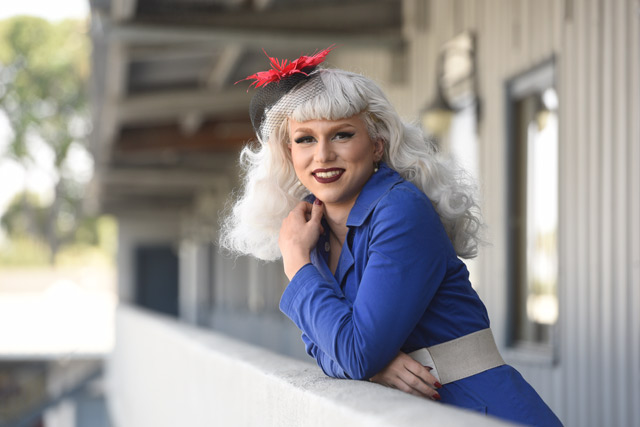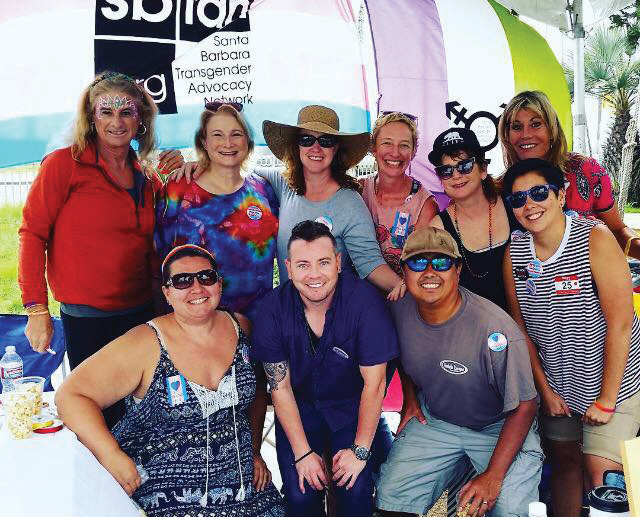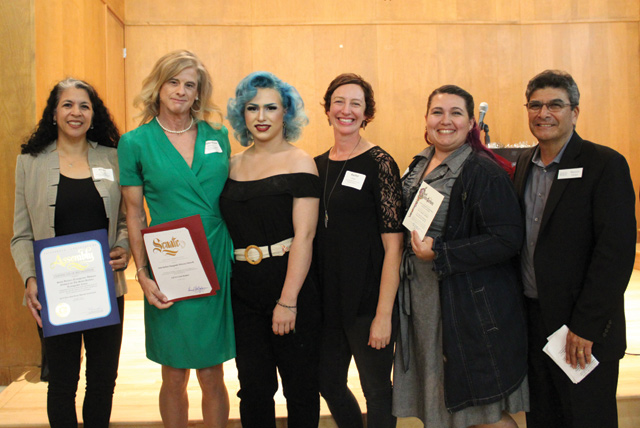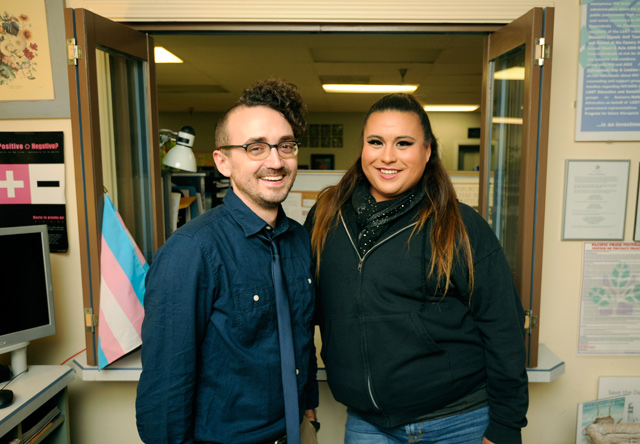Transgender Life in Santa Barbara
Transgender Prom Queen and Religious Leaders Are Changing Santa Barbara’s Attitudes to Gender Identity

Crowned the Queen of the Prom on the night of May 21, 2016, Blue Nebeker stepped into the spotlight and into Santa Barbara history. The first transgender prom queen at Santa Barbara High School (SBHS), Nebeker’s coronation signaled a momentous cross-generational shift taking place. To many it looked as though the traditional rules and roles of gender and sexuality were being dethroned.
Hardly anyone at school seemed surprised by Nebeker’s victory. To most SBHS students, theirs was not only a vote for a popularity contest but also a vote for change. Nebeker was selected as queen, her classmates told reporters, because they knew her as brave and bold, disarmingly charismatic, and downright hilarious, a leader among her peers. Nebeker herself didn’t seem terribly surprised with her election. “Once I got nominated, I was like, we know who’s actually going to win this,” she said.

The prom brought Nebeker a moment of joy on a sometimes difficult journey. Growing up Mormon, she admitted that she experienced a lot of anxiety during her struggle to understand her true self, especially when some family members expressed disbelief and disapproval. In the 9th grade, Nebeker began to realize she perhaps wasn’t a gay boy, as she had first thought, but someone else. Nowadays, the dazzlingly confident and self-aware Nebeker can usually be seen in ’40s and ’50s pinup-girl-inspired ensembles. “I’m taking something and flipping it,” the aspiring cosmetologist said of her look, a way of redefining what it means to be feminine. A youth advocate leader for Pacific Pride Foundation (PPF), Nebeker walks her queer classmates and allies to PPF youth groups after school, assuring them it is not only okay but great to be who they are. Patrick Lyra Kearns, the outreach advocate at PPF, saw “her courage and her visibility” as giving younger kids a feeling of safety. This feeling of safety is increasingly important, transgender advocates have said, because of remarks from some within the new presidential administration, such as the recently appointed Housing and Urban Development Secretary Ben Carson, who called transgender identity “the height of absurdity.”
Nebeker’s coronation, however, came at a time when the lives of transgender individuals in Santa Barbara and across the nation were not being treated as an absurdity at all, but as part of nature and a fact of life. Thanks to the work of the Santa Barbara Transgender Advocacy Network (SBTAN) and PPF, S.B. county schools, churches, hospitals, and workplaces have made huge strides toward understanding and acceptance. In early December, the Fund for Santa Barbara awarded SBTAN a grant to run the S.B. Transgender Center, a by-trans, for-trans gathering place hosted by the First Congregational Church. As the whole country braces for a sharp shift to the ultraconservative right, Santa Barbara has a chance to become a crucial model for how a community can embrace and protect transgender lives.

What Is Transgender?
That there is more to human life than being strictly male or female is not even a new idea for Santa Barbara societies. The Chumash traditionally recognized a third gender, called ’aqi, biological men who wore women’s clothes and performed women’s roles. Throughout all of human history, in fact, societies have had varying ideas of what makes a person a man or a woman or both or neither — whether chromosomal pairings or bodily traits or societal roles. Today a person is transgender (or gender variant or gender nonconforming) if their inner lives and sense of self do not correspond with their biological sex. The term “trans,” which comes from the Latin meaning “across” or “over,” applies when the gender glove doesn’t fit a person.
Transgender people often describe similar emotions that they experienced before transitioning: You can feel dislocation, disconnection, and dispiritedness in yourself and the world around you or just a vague agitation, like your skin is too tight, the clothes you are meant to wear make you ill, or the word that people use to refer to you makes you feel invisible. There’s a longing for an unlived life you carry inside you or for a person as yet unseen. Gender dysphoria is the name for that experience. It is very deep, very physical, very emotional, and very real.
As someone who doesn’t identify exclusively with either gender myself, the gender journey has meant unfurling new horizons, expanding my heart and mind, finding a lightness that had long eluded me. Many little puzzles of my inner life now feel solvable, and I make a little more sense with my soul. In my so-called height of absurdity, I have felt closer to people and more human as I’ve come to understand that I’m not just masculine but feminine in my ways, too — on a deep level. So as Nebeker and I and so many others have discovered, to be transgender or gender nonconforming can be a freeing, liberating, wonderful experience.
When I spoke with Deja Nicole Cabrera — PPF community outreach associate, one of Santa Barbara’s most celebrated performance artists, and a woman who was assigned male at birth — she agreed that transitioning is a life-affirming experience. Cabrera said she always knew she was attracted to men, but she didn’t identify as a gay man. “I tried to pray the gay away.” When she became a performance artist working in Las Vegas, trying on femininity allowed her to realize her true self; as a religious woman, transitioning also allowed her to feel in sync with her spiritual role on Earth. “I felt normal. I felt like I was no longer living in sin.”
For many, crossing the gender divide means going by a new pronoun: no longer “he,” but “she,” or even “they,” if neither feels fitting. If you once knew a person as a “she” and they are now identifying as a “he” or going by a new name, the most respectful thing you could do is honor their request. Though it can be a difficult process to readjust, using the wrong word can be devastating. “It invalidates everything you’re trying to do,” Nebeker said.
It’s an adjustment for all involved, with some serious mental rewiring required. Even the most supportive and well-meaning of parents, such as Blue’s mother and father, Jo and Eric Nebeker, admitted there were moments of guilt and unintended hurt as they adjusted to the correct pronouns and emotional acknowledgements. To other parents, Blue’s mother advises, “Support and forgive yourself. Talk to your kids and apologize to your kids. As long as your kids know you’re trying, there’s a lot more leeway.”
Finding the right word and identity for oneself isn’t an easy or clear process. “I didn’t have the vocabulary,” Blue said of her early years. As a kid, she felt a pang of recognition in Disney princesses and pinup girls, a beauty she wanted to emulate. “She always liked girl things from when she was a baby,” Eric remembered. Both parents recalled Blue testing the waters of gender expression and self-identity until she fully presented as a woman in dress and manner. “Her whole personality changed; she was much happier, socially much less timid. She had been very shy before — something which seems unbelievable to people now,” Jo said.

—Genevieve Le Duc (left, with Avalon Jenkins-Balke)
Genevieve Le Duc, owner of Segway of S.B. and an athlete who has swum in a relay race across the S.B. Channel, recalled the profound sense of loneliness she felt growing up in the ’60s. Assigned male at birth, she was raised in an Irish-Catholic household with five brothers. “I knew pretty quickly my behavior and desires were different and not super acceptable,” she said. “I always felt that I was trying to be a person I was having to manufacture, not me.” Back then, only the language of adult stores, with their crates of “transvestitism” and “female impersonation,” offered some slight semblance of self-definition. “Growing up, there was no middle. If you were trans, you were perverted.”
Le Duc, who is now married to the Olympic cyclist Avalon Jenkins-Balker, described their wedding day this April as Santa Barbara’s first-known transgender marriage. It was, for both athletes, an incredibly joyous occasion, the kind of joy earned only after decades of turmoil. Le Duc demonstrates what kind of happy rewards can await a life with enough endurance and strength, and while not all of us can set world records swimming from Santa Cruz Island to East Beach, there is something very universal in her life’s interpersonal hurdles. “We’re all trying to achieve the same end, which is to be yourself,” she said. When Le Duc came out as a woman in her first marriage years ago, it was a torturous and shaming experience. “It takes a lot of balls to come out as a woman,” said Le Duc. But perhaps it will not be as devastating for today’s younger, more gender-versed generation. People such as Blue Nebeker and Sabrina Dabby, a bisexual and gender-fluid individual who was elected SBHS’s King of the Prom this year, are helping to normalize identities. PPF’s Kearns believes that “they are helping map what it means to be human.”

A Sense of Self, a Sense of Family
Gender definition begins in very early childhood. SBTAN Executive Director Rachel Gloger and her husband, Barnaby Gloger, are parents of a transgender child and cofounders of TransYouth Santa Barbara. They recognized the critical need for family support to help a child navigate the gender journey. Rachel Gloger described TransYouth as helping “trans-supporting families build community, celebrate our really magical kids together, and find a place where our kids feel valued.” It certainly seems to be providing a service. When the group began nearly two years ago, Santa Barbara had no resource for families with transgender children. They started with three families. Today there are more than 40. Having parental support makes a profound difference. In the 2015 U.S. Transgender Survey, released December 8 of this year, 40 percent of respondents reported attempting suicide in their lifetime — nearly nine times the attempted suicide rate in the U.S. population (4.6 percent) — and for youth, the numbers are also dramatic. More than half of unsupported trans teens attempt suicide; 37 percent of trans teens with supportive families do.
“A lot of the families that come to our group are just terrified. There’s so much media narrative, with a realistic lens, about violence toward trans people — a lot of families know that narrative, and they’re scared,” Rachel Gloger said. Parents can want the best for their child and fear that helping them transition may endanger them. “They’re holding the fear: What is safer for my kid? Not allowing them to transition and then having all these terrible mental outcomes, or if I have a trans kid, will my church still accept me? My family, my job?” And sometimes parents and family experience grief for the person that no longer appears to be, according to Bren Fraser, PPF’s clinical supervisor. “Their grief is organized around their own specific hopes, dreams, and images that they had for and about their child.”
A Need for Greater Care
Health care remains perhaps the biggest institutional barrier for transgender individuals in Santa Barbara. To address this need, UCSB hosted the first-ever medical conference in early October on providing sensitive clinical care to transgender children, adolescents, and young adults. Doctors are becoming fluent in the medical needs of people who, not long ago, were completely ignored. Three primary care providers in Santa Barbara now offer transgender-sensitive services, and Cottage Hospital emergency personnel and the S.B. Police Department staff alike have been trained to ask an individual’s preferred pronoun.
However, crucial services are lacking, not just in Santa Barbara but throughout the state, particularly hormone replacement therapy and surgery. One of the closest medical facilities offering such treatment is the Santa Paula West Medical Clinic in Ventura County. In order to undergo a sex change surgery — an operation not every transgender person needs or desires, and one even fewer can afford — a patient must have as many as three letters of approval: one from a hormone replacement therapist and two from mental-health officials.
“Historically, trans patients have had to prove to the medical system that they are trans in order to get care,” said Dr. Jake Donaldson, a physician at the Santa Paula clinic. This “gatekeeper model” means the doctor, not the patient, knows the patient’s core identity and can pose “all these hoops and protocols to get the care the patient needs.” Donaldson sees the system evolving to an informed-consent model, in which the patient is informed about the risks and benefits of surgery but is assumed to understand their own identity. Because such procedures still require adult consent in order to get a doctor’s approval, young people who know they are trans must often wait years to become themselves. Aydin Olson-Kennedy, director of the L.A. Gender Center (where many S.B. families have visited), is a huge advocate for early transitioning methods, even if a child cannot consent to surgery until 18.
For the most vulnerable members of the transgender population — those who are homeless or in the sex trade — their chances of getting proper medical support are almost nonexistent. They are most likely participating in “survival sex” because they were thrown out of their homes or otherwise emotionally and financially abused due to their identity. In the 2015 study Meaningful Work: Transgender Experiences in the Sex Trade, trans sex workers reported far higher rates of HIV (including 40.6 percent of black respondents) and far higher rates of homelessness (39.5 percent were denied access to a shelter). Those in S.B. who are undocumented, dispossessed, or unwelcome at home are hit the hardest, and for many, a safe space and a secure life simply do not exist.

A New Normal
But school by school, business by business, a new normal is setting in. Spearheaded by PPF and SBTAN, institutions countywide are changing. Gender-neutral bathrooms have popped up at UCSB and Dos Pueblos High School (DPHS). After some initial curiosity and confusion, DP’s bathrooms are a nonissue. “The novelty was short-lived and benign,” said DPHS Principal Shawn Carey. “And meanwhile, what it means to our gender nonconforming students is … it’s on a whole other scale. You take this little inconvenience of doing something a little different and compare that to the benefit we are conferring practically, psychologically, and sociologically, and there’s just no argument. … There’s no reason to not have this be the practice at all of our schools.”
While so many have been shunned for their identity on account of their family’s religious beliefs, Santa Barbara has a number of churches that offer sanctuary to all. At Isla Vista’s United Methodist Church, Rev. Franklyn Schaefer, who became an international icon when he was defrocked for officiating at the wedding of his gay son, said, “In my book, [transgenderism] has never been a problem. We have always emphasized the soul over the body. … Why as a church should we not stand behind it?” he asked. “You finally get to be the person outwardly that you feel inside. That transition is a beautiful, wonderful, joyous thing.” Reverend Julia Hamilton, at the Unitarian Society of S.B., echoed these sentiments. “To be a human being is to have worth. There is no gender attached to divinity in our belief … There are only incarnated differences between heads and hearts,” she said.
And then there are the role models, the transgender community leaders themselves. There are role models such as PPF’s Patrick Lyra Kearns, striving to elucidate the multifold, nuanced nature of humanity. “The world is a little more in the gray, on a lot of levels,” Kearns said. “People are really kind of getting more fluid and more plastic in the way they think about everything. It’s okay for people to be in between.” There are role models such as SBTAN’s Phillippa Bisou Della Vina, who, in her KCSB radio program, showcases the artistry of the liminal space and the subconscious mind, through the creativity and courage that is uniquely trans. There are role models like Deja Nicole Cabrera, who shows her Latina sisters in the trans community that they can be empowered, like her, as she holds down a full-time job by day and delights at drag brunches on weekends. “Stay confident in who you are and who you want to be. The right time will come around, and things will flourish,” Cabrera said. There are role-model business owners like Genevieve Le Duc, who show that in the long race of life, they can still find their happiness and live in harmony with themselves. “I hope people realize we are just people,” Le Duc said. “We’re just like anybody else. We’re people that love our children and want the best for our friends and community. We all have to help each other; we need to be together, regardless of who we are.”
And there are role models like Blue Nebeker, the inspiring teen queen helping lead the way all over town. “Apparently, people like me like a lot,” she said.



